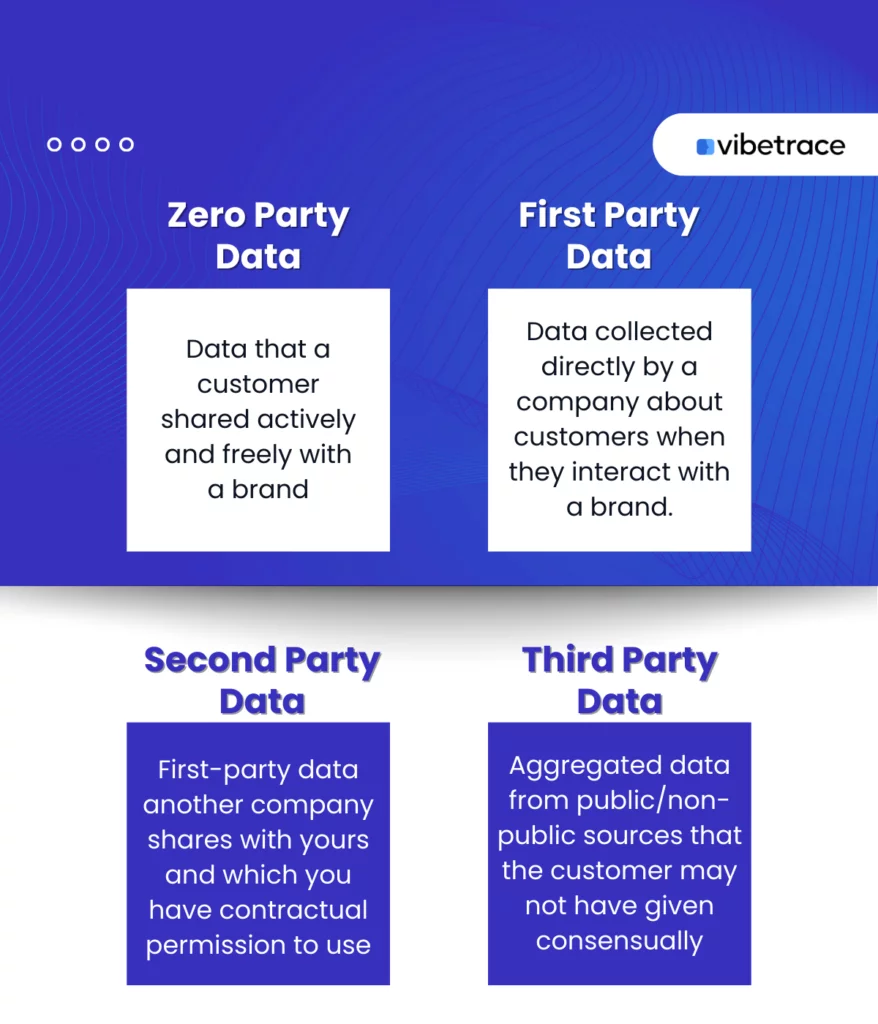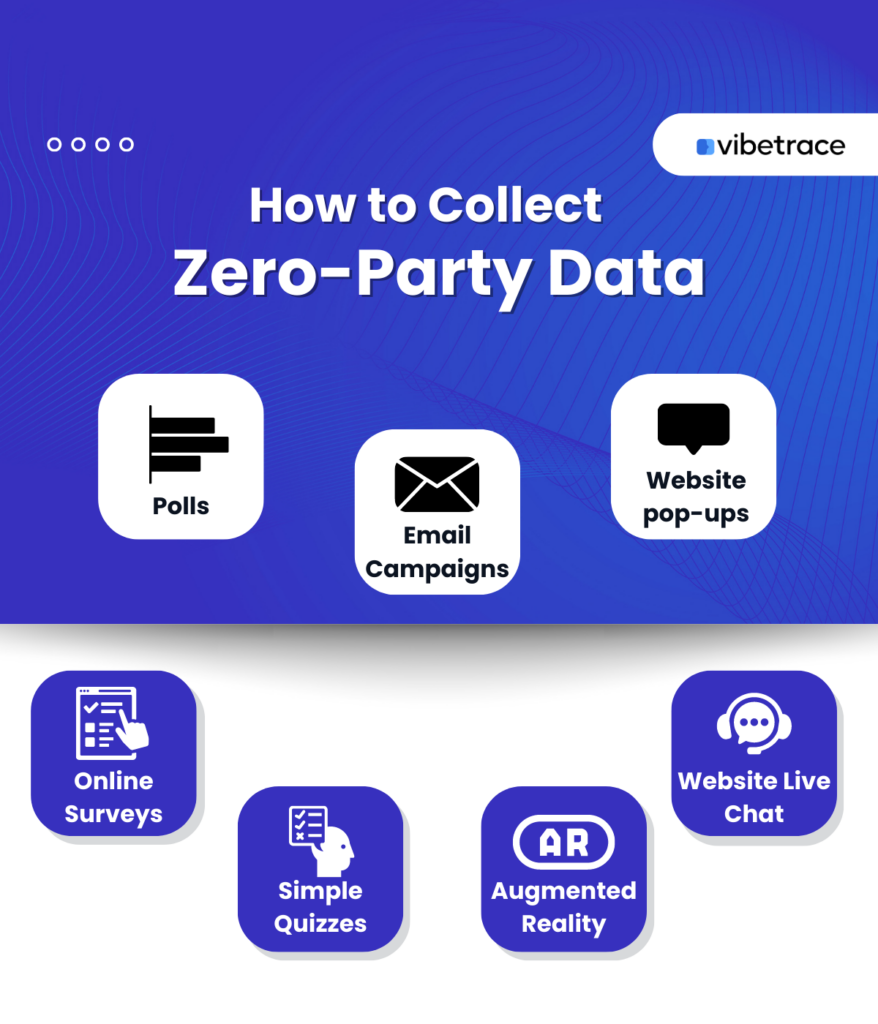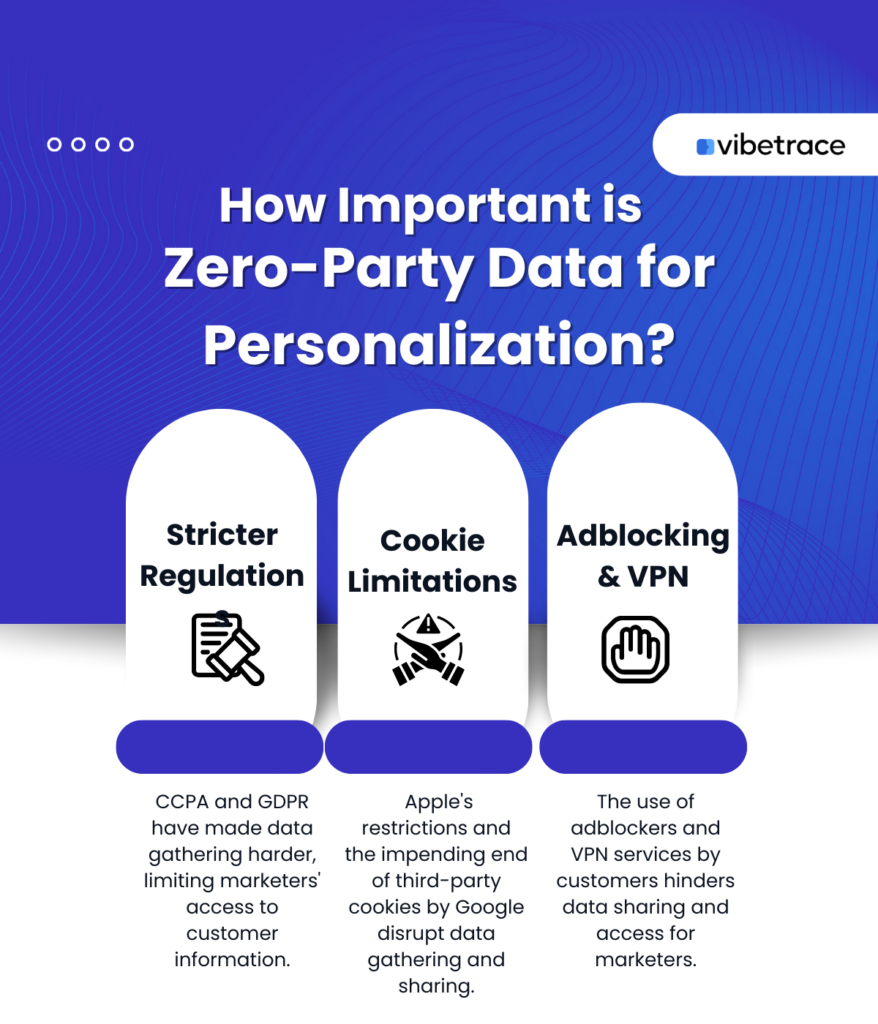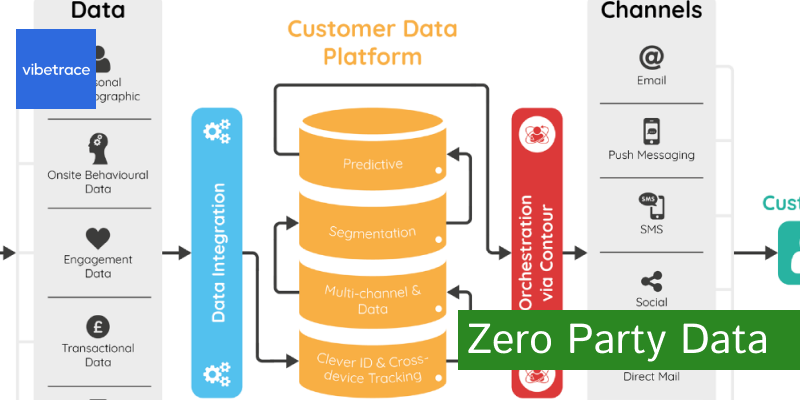Zero-party data has always been a valuable source of reliable user information. With the shift toward user privacy on the Internet, it’s been growing in importance over the last several years.
To help you better understand what this is and how you can use it to achieve better results, we created a detailed guide on the topic. In today’s article, we’ll discuss everything from zero-party data examples to the ways you can gather it and the ways you can feature it in your strategy.
Keep reading if you want to be GDPR and CCPA compliant and still gather valuable user information that can help you increase e-commerce results.
What is Zero-Party Data?
Zero-party data, in a couple of words, encompasses information that the customer intentionally and of their own volition shares with a business. We’ve discussed in detail the variety of permission-based communication channels you can use in your marketing mix. Collecting zero-party data also requires the willingness and permission of customers.
In other words, you’re open with your target audience, and they’re aware of sharing information with a brand. This type of willingly given information is the most reliable way to get to know your customers better.
Are you already gaining an idea of what zero-party data looks like and how it can be gathered?
Examples of Zero-Party Data
What makes it stand out from the other sources is customer consent. The most obvious examples include:
- Email subscriptions;
- SMS marketing subscription;
- Poll participation;
- Survey participation;
- Filling out lead generation forms;
- Downloading online resources;
- Online chat, and more.
All these give you the opportunity to seek out your customers and ask them open-ended questions. The goal is obvious – providing a better, enhanced user experience tailored to your customer’s preferences and needs.
Is that all? Below we’ll make a comparison between the four main types of data to see for yourself.
How Does It Compare & Why It’s Beneficial?
Customers express more and more concern about their privacy online. When you evaluate your data sources, you can clearly see that the least concerning option is zero-party data. Here’s how it compares to the rest:

| ZERO-PARTY DATA | FIRST-PARTY DATA | SECOND-PARTY DATA | THIRD-PARTY DATA |
| Customers share information directly. | Data collected from customers’ interactions with your channels. | Information coming from one of your corporate partners. | Information that’s aggregated and sold by a third-party company that didn’t collect it. |
The way data is acquired gives it specific characteristics:
- Zero-Party Data – shared willingly, highly accurate.
- First-Party Data – you own it, but amassing data is time-consuming.
- Second-Party Data – questionable reliability.
- Third-Party Data – non-exclusive, raises privacy concerns and reliability questions.
As you see for yourself, customers share with intent only zero-party data. Now that data privacy concerns are peaking, this is the only source that guarantees you respect customers’ privacy. You care about it.
While it’s not illegal to collect all other types of data, they can’t provide the same benefits, as you’ll see below.
Benefits of Using Zero-Party Data
Knowing your customers better is undeniably the greatest benefit of collecting such data straight from the source. But that’s not the only one:
- Campaigns for collecting it boost customer engagement;
- It helps you generate better customer profiles and detailed segments;
- Allows you to hyper-personalize customer experiences;
- Interactions for collecting zero-party data build trust and imply customers can receive value from sharing information with your brand.
All that has a massive effect on growth and building lasting relationships with paying customers. To help you kickstart that process, we gathered viable ideas which you can use to start collecting zero-party data today!
There are many benefits to zero-party data. For one thing, your business can use this data to provide an experience for the customer that goes above and beyond what your competitors might be offering.
Zero-party data has the potential to provide businesses with a much clearer understanding of what their customers are looking for and what their expectations are.
This quality data could give them a competitive advantage. If you aren’t acting on this, there’s a good chance at least some of your rivals already are.
Data quality and accuracy
Zero-party data provides much higher data quality and accuracy. This allows businesses to work on a more concrete understanding of their customers, rather than inferring consumer preferences from previous interactions and purchase history. This also makes it easier for brands to build close, lasting personal relationships with consumers.
Customers increasingly expect personalised experiences. Businesses which provide these experiences—sometimes even in real time—are likely to profit as a result. Those that don’t, on the other hand, are likely to lose out to their more flexible and attentive competitors.
Relevance
Zero-party data is more directly relevant to customer needs and preferences than first-party data. It gives them the opportunity to tell you more about what they want, which most consumers are only too happy to do (especially if they’re getting a littlebonus in return).
Because first-party data is based on previousinteractions and implied customer preferences, what it can tell us is quite limited. You can hypothesise based on what customers have done in the past, butit’s not easy to accurately project their future decisions on that basis.
By contrast, zero-party data is actively provided by customers. In ourexperience, customers will provide data, regardless of their privacy concerns so long as retailers make it worth their while (by rewarding them with unique discounts and offers, for example). They’ll also want reassurance that the process is a transparent one.
Cost-efficiency
Another important point to bear in mind here is that zero-party data can be much more cost-efficient than other types of data. If you’re watching your business’s pennies, this matters. A lot.
This is, again, in part because of its greater reliability and precision. By giving customers the option to provide information, we can gain a much deeper understanding of their opinions, needs, and preferences, straight from the horse’s mouth.
Businesses can use zero-party data to devise personalised campaigns at each stage of the buyer journey. This can help to boost customer satisfaction and foster lasting consumer loyalty—the cornerstone of success for any business—in a cost-effective manner.
Compliance
Governments and regulators in various parts of the world have sought to improve consumer privacy by strengthening data protection law. This is partly in response to consumer pressure, and growing awareness of the importance of data security.
As a result, businesses are subject to much more stringent data protection requirements than they were previously. They must ensure that they source data in a way that complies with these new requirements. You’ve got to make sure you play by the rules.
When purchasing data from a third party, however, it’s not always easy to ascertain whether that data has been obtained in a GDPR-compliant way. Some third-party data providers are more reputable than others. Complementing first-party data with zero-party data can help businesses avoid some of the pitfalls commonly associated with third-party data.
How to Collect Such Data?
Collecting zero-party data allows you to be creative and come up with dozens of ways to reach and engage your customers. Some of the most popular options include:

- Polls on your social media pages;
- Email campaigns asking customers to re-subscribe in exchange for a discount;
- Website pop-ups offering discounts in exchange for subscribing;
- Online surveys – great for engaging customers and gathering feedback at the same time;
- Simple quizzes on product and recommendation preferences – essential for beauty brands and cosmetics because every person has specific needs.
- Augmented reality – through apps that allow customers to try apparel, accessories, and even cosmetics to see how they’ll look before making a purchase.
- Website live chat with pop-up questions – customers can rate their experience and share what notifications they’d like to get, tell what they’re interested in, and so on.
Some of those tactics are quick and easy to execute. Others will require planning and resources. How imaginative you’ll get depends entirely on you – there’s no limit.
You’re probably asking yourself if it’s worth investing time and energy to do all that? After all, there are so many other customer data sources that you can use.
The answer is a resounding YES, especially if you take personalization seriously. In the next section, we’ve prepared a quick overview of how to combine zero-party data with your overall strategy. Don’t miss it!
How to Use Zero-Party Data?
You cannot afford to stop at collecting such data. The whole point of approaching your customers and acquiring their consent is using the most reliable source of information to create better experiences and campaigns. That’s why you must take the following actions:
1. Integrate Zero-Party Data
Align the information you gather straight from the customers with all tools and data you’re using. That means:
- integrating it into your buyer profiles and customer segments;
- adapting content to align with the information you’ve gathered;
- adjusting your overarching marketing strategy to account for such data.
That way, you can ensure all your communication channels and marketing campaigns will reflect it. You can track your efforts through analytics reports to see how customers respond to the adjustments made for their zero-party data.
Last but not least, by integrating it into your processes, you’ll break down data silos that have been proven to be detrimental to overall campaign performance and ROI.
2. Communicate Value
Since you’re soliciting consent and cooperation, you’ll usually need to provide an incentive for customers to take the action you want them to.
Do you like this article?
Join our CX for Retail dedicated newsletter!

Stay connected to what’s really important to optimize your digital revenues.
By clicking the button, you accept our Terms & Conditions. Also you will need to confirm your email address.
When you ask for zero-party data, clearly state how you’ll use it. Point out how customers will benefit from providing such information. You can offer them:
- Additional Discounts – for example, when they provide feedback or leave reviews;
- Better Experiences – tell them how their experience on your online store will improve. It might be anything for enhanced recommendations to better customer support.
- Hyper-personalization – be explicit when asking about preferences. Show your customers you’ll send them specific offers aligned with their distinct needs. As I said, that’s a go-to approach, when it comes to beauty and skincare products. You can adapt it to fashion and apparel by inquiring about body type, for example, and adjusting recommendations accordingly.
People care about how brands will elevate them with their products. Communicate the value you offer when they share specific details or opt-in for permission-based marketing materials.
When you do that, you’ll be able to effectively feature zero-party data in your marketing strategy. Let’s see where and how it fits!
3. Custom reactivation campaigns
Cart abandonment is a big problem for retailers. A lot of customers put items in their online shopping cart and then simply leave them there, without completing a transaction.
With Ve, customers who leave a site without completing their purchase have their cart history saved. It can also deliver custom campaigns to encourage reactivation and nudge customers to go through with their purchase.
4. Add Zero-Party Data to Your Strategy
The customer must be at the core of every marketing strategy today if e-commerce businesses want to succeed. Here’s what your strategy might look like if you start using zero-party data:
- Get more traffic to your website;
- Ask specific questions and communicate the value people will receive for answering them;
- Make precise, highly-personalized recommendations across communication channels;
- Use the gathered data to personalize workflows and advertising.
When you feature such data into your overall strategy, you can use it:
- To create unique experiences at every touchpoint;
- For advanced ad retargeting;
- For highly-personalized email marketing workflows by adding tags and triggers;
- To improve the product recommendations that you make by using a product recommendations engine;
- To send out targeted, highly-relevant web push notifications;
- To create more detailed buyer profiles and customer segments;
- To A/B test campaigns for different buyer profiles with specific traits and improve campaign results;
- To examine and better understand customer behavior and what makes people abandon brands.
As a result, you’ll provide a massive improvement to customer experience. By leveraging zero-party day, you can reduce customers that abandon your brand, recover abandoned carts, improve customer retention, and more!
All that just by actively trying to align offers with your customers’ interests and needs.
But if you can create personalized experiences through first-, second-, and third-party data, why make the effort to collect zero-party data? In the next section, we’ll closely examine why it’s growing in importance.
How Important is Zero-Party Data for Personalization?
Zero-party data’s importance skyrocketed in the past couple of years. The reasons for that are regulatory and technical. They both relate to customer privacy and impact our ability as marketers to collect information on target audiences.
That, in turn, affects our ability to personalize experiences when that’s all customers require of us. To help you understand the risks to personalization efforts and how to offset them with zero-party data, let’s see what they entail:

A. Stricter Regulations
Privacy laws made data gathering harder. With the introduction of the CCPA in the US and GDPR in Europe, marketers face new challenges. The way we use and handle personal information changed – customers can even request their data to be deleted.
These new regulations hit social media channels as a source of information as well. Platforms like Facebook and TikTok limit the data they share to stay compliant.
Users go as far as entirely closing social media accounts because of data breaches and mishandling of personal information. That’s another major blow for marketers that use social media channels to gather data on their target audience.
B. Cookie Limitations
Apple caused a shift in gathering and sharing data by limiting access to data gathered from Apple devices. Data aggregators that act as third-party data sources and social media platforms were disallowed from collecting information.
Then came Google’s announcement they’ll put an end to third-party cookies. Even though the step was pushed to 2024, it will happen eventually. That means marketers must be ready when it does. Zero-party data can offset the massive impact that ending third-party cookies will have.
C. Adblocking & VPN
Last but not least, customers themselves limit data sharing and access by using the increasingly popular adblockers and VPN services. Not only do people choose to see no ads at all, but they can also create further obstacles by hiding their online activity from third parties, including advertisers.
The current VPN market amounts to more than $44.6 billion and the trend is rising. And even though slowly, adblocking keeps growing, reaching a 27% user penetration rate in the US in 2021.
As you can see, challenges for marketers will continue to grow. The only way to stay ahead of the changes in regulations and consumer behavior is to be as close as possible to your customers. That’s where zero-party data will prove to be a game-changer. And soon enough.
Where to Start?
When it comes to e-commerce, your main goal is to attract and engage potential and existing customers. By adding zero-party data in an integrated marketing strategy, you’re one step closer to achieving this goal and getting the results to show for it.
If you’re ready to begin, don’t hesitate to utilize a robust, all-in-one marketing platform that will allow you to integrate your efforts, streamline your processes, and personalize the customer journey at every touchpoint. Check out what VibeTrace can do for your marketing – book your demo today!
Other types of customer data
There are other types of customer data aside from zero-party data, in case you didn’t already know.
These other types of data can be grouped into three general categories: first-party data, second-party data, and third-party data.
Want to be up to date with Marketing?
Subscribe to our Retail CX newsletter!

Stay connected with what’s really important to optimize your digital revenues.
By clicking the button, you accept our Terms & Conditions. Also you will need to confirm your email address.
First-party data
First-party data is highly prized by businesses for its quality and accuracy. There are some similarities between first-party data and zero-party data—namely, they’re both derived directly from consumers—though there are also some important differences between them too.
What is it?
As with zero-party data, first-party data is sourced straight from customers. This means that it’s easy to keep track of where the data comes from, which helps to address privacy and data protection requirements. First-party data can be used both to forge deeper connections with and learn from consumers, as well as improving return on investment.
Here’s the key difference between the two: First-party data is drawn primarily from website analytics and user behaviour monitoring, while consumers directly provide zero-party data themselves.
First-party data can be derived from various sources, including your customer relationship management (CRM) software, social media profiles, and website analytics.
Zero-party data, on the other hand, is intentionally shared by consumers.
The latter, therefore, helps to actively build trust between your business and its consumers, while the former provides insight into their behaviours. Both are hugely important.
Why it’s important
First-party data is highly prized by businesses because of the insights it can provide into user behaviour, and because it can thereby help firms understand their consumer base that bit better.
It’s also valued for its accuracy, as it’s derived directly from consumers.
Pitfalls and issues
Some businesses struggle to make effective use of first-party data because they’re unsure of the privacy concerns relating to it. It’s one thing to put it all down to trial and error, but the errors can be costly.
To make good use of first-party data, businesses must ensure that they collect, clean, store, and deploy it properly, in accordance with the relevant legal requirements. These technical challenges can be quite a burden for some businesses.
Second-party data
Second-party data, as the name implies, is data which is collected by one party and then shared with another. In effect, it’s somebody else’s first-party data. It has a number of uses for businesses and is widely used to help deepen understanding of consumer preferences.
What is it?
Second-party data is obtained directly from the firm that controls and originally gathered it. There are some similarities with first-party data with regard to the types of data and where they’re originally sourced from. Second-party data might also include social media activity, customer surveys, website analytics, and app usage, for example.
Why it’s important
As with first-party data and zero-party data, second-party data can provide retailers and other businesses with a deeper understanding of their customer base. The better you know your customers, the better you can serve them and keep those virtual tills ringing.
Privacy issues are minimal, because the data is purchased straight from the company which originally sourced it, which should—so long as the vendor is reputable, of course—ensure compliance.
Pitfalls and issues
Second-party data must be handled in an appropriate, ethical manner. Those sourcing second-party data must ensure that their partners are above-board and reliable.
It’s also important that the firms involved are a good fit with one another and have sufficient goals in common; incompatibility between partners can cause problems further down the line. That sort of aggravation is the last thing you need.
Third-party data
Third-party data is data which is sourced from businesses which have themselves obtained that data from another party.
It’s commonly used to make behavioural, contextual, and demographic targeting more accurate, so that specific segments of a consumer base can be targeted with greater precision and accuracy.
What is it?
There are data aggregators which buy data from the various websites where it was originally generated. This is what’s known as third-party data; it’s collected into large data sets and then sold on to other companies which want to make use of it.
Why it’s important
The key benefit of third-party data is the scale it provides. It allows businesses to delve deep into consumer data, obtaining detailed insights into their behaviours and preferences. It can therefore enable these businesses to reach new markets and demographics, by helping them better understand the consumers they’re attempting to reach.
Pitfalls and issues
Some businesses buy third-party data without having a clear plan for integrating it into existing workflows. This can leave them with a big, confused collection of data which they don’t really know how to use—and slowing productivity.
Piling up data in this way may simply leave you feeling overwhelmed and confused by it.
Useful Links:

